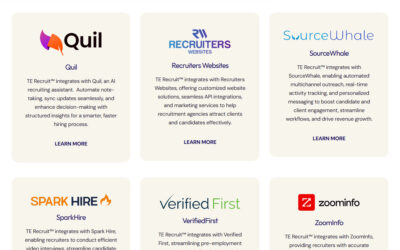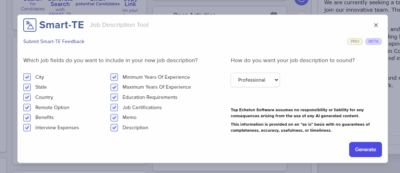(Editor’s note: The information from this article by Top Echelon Recruiting Software has been taken from an Expert Recruiter Coaching Series webinar by Rob Mosley of Next Level Training titled, “Negotiation in a New Era: How Recruiters Can Build Trust” Click HERE to watch the video of that training webinar for free.)
In today’s world of recruiting and staffing, the word negotiation often conjures images of final-round haggling — contracts, fees, and terms. But if you ask Rob Mosley, a global negotiation expert and partner at Next Level Exchange, negotiation begins long before any paperwork is drafted.
“Every step of our sales process with clients and candidates is a negotiation,” said Mosley. “When you first open a conversation with a valued client or candidate, you’re negotiating for the right to have a valued conversation. That’s procedural negotiation.”
Mosley, who has facilitated negotiation training in 88 countries and 14 languages over three decades, delivered a dynamic, content-rich session for Top Echelon members. Drawing from global best practices validated across the staffing industry, he unpacked a powerful truth: negotiation is not just a skill — it’s a mindset and a process embedded in every interaction we have.
The Heart of Modern Negotiation: Business Principles
Mosley began by grounding the session in two foundational business principles — concepts he believes separate effective consultants from commoditized vendors.
“A principle is where what’s smart meets what’s right,” he said. “And because these are fundamental truths, you only get two choices: you can leverage them, or you can violate them — and then become the victim.”
Here are the two principles Mosley encouraged attendees to internalize:
-
Short-Term Behavior Has Long-Term Consequences
If you fail to differentiate your value through how you engage — your professionalism, preparation, and problem-solving — you’ll be forced to differentiate by price. And that’s a losing game. -
Easily Won Concessions Are Rarely Valued
“And almost always lead to more demands,” Mosley added. “You can’t suck up your way into a collaborative relationship.”
These truths remind us that giving in too quickly doesn’t build goodwill — it signals weakness. “If you have kids,” Mosley joked, “you already know that’s a great religious truth.”
Escaping Vendorville: The Real Definition of ‘Vendor’
Too many recruiters are caught in what Mosley calls Vendorville — and he means it literally.
Citing the American Heritage Dictionary, Mosley broke down the definition of vendor:
“One who sells. A hawker, peddler, huckster, monger, purveyor.”
Even the example used in the dictionary? “The guy who sells peanuts in the ballpark.”
“If we’re seen as vendors, it’s not because our clients dislike us,” he explained. “It’s because they don’t perceive value in what we bring to the table.”
When you’re perceived as a commodity, the negotiation is lopsided, aggressive, and almost always about squeezing you on terms. To change that, recruiters must aim higher — to become subject matter experts, collaborative partners, and trusted advisors.
So Goes the Relationship, So Goes the Deal
Mosley offered a mantra that crystallizes how perceptions shape outcomes:
So goes the relationship, so goes the negotiation, so goes the sale.
If you’re seen as a consultant with expertise, the client treats you with respect. Negotiations are more balanced. The placement process is smoother. But if you’re perceived as a transactional vendor, expect difficult conversations, power plays, and last-minute curveballs.
Mosley emphasized that our goal should be to move from being an order taker to a collaborative partner. This isn’t about semantics — it’s about how clients and candidates choose to treat you.
The Trigon: Understanding Your Relationship Dynamics
To help attendees assess their relationships, Mosley introduced a tool called the Trigon — a triangle that illustrates the three kinds of relationships recruiters can have with clients or candidates:
-
Competitive (Red)
-
Cooperative (Yellow)
-
Collaborative (Green)
Competitive relationships are adversarial. There’s low trust, misaligned goals, and every interaction feels like a tug-of-war. Clients may say things like, “Take it or leave it,” or “We have lots of vendors who would work on this at a lower rate.”
“Life in the red is life in hell,” Mosley quipped. “It’s the game show Survivor. Only one person can win, and if your client wants to win, that means you lose.”
These relationships are marked by perceptions of conflict. “It’s not that clients are bad people,” Mosley said. “It’s that trust is thin, and when trust is thin, power is used against you.”
Cooperative relationships offer more balance. There’s some mutual respect, and clients acknowledge the value you bring — but you’re still replaceable. Mosley warned that cooperative clients may appear loyal until the landscape shifts.
“A merger, a change in leadership, a bad hire, a pandemic — any of these can snap a cooperative relationship right back into the red.”
Collaborative relationships are the holy grail. You’re brought into strategic discussions. Clients ask your input before the RFP is written. You may have retained agreements or exclusivity. Trust is high, power is shared, and your insight is sought, not just tolerated.
“You don’t need a lot of collaborative relationships to move the needle,” Mosley emphasized. “But you need a few.”
He encouraged attendees to evaluate their client portfolios. Most firms, he said, live in the red 60–70% of the time, with 20–30% in yellow and only 5% in green. The goal? Spend your time elevating relationships and investing where trust can grow.
The Tactics Clients Use — And How to Spot Them
A major segment of the webinar focused on tactics — the subtle (or not-so-subtle) negotiation moves clients and candidates use to tip the power scale in their favor.
“Tactics are tools used at the competitive level,” Mosley explained. “They influence our perception of what’s fair and smart — and they’ve worked for a long time.”
Some of the most common tactics include:
-
Negotiating 101: “Your price is too high.”
-
The Tease: “We’re so close… just one more tweak.”
-
Flinch: A dramatic face or tone change meant to unnerve you.
-
The Messenger: “My boss said we can’t move forward unless…”
-
Square One: “If you can’t be more flexible, we’ll start the process over.”
-
Carrot: “If you give us this discount now, we’ll give you more business later.”
-
Fair and Reasonable: “Given how much money you’ve made from us, a 20% discount seems fair.”
Mosley’s advice? Recognize these for what they are — tactics. Once you see them, they lose their power.
“They’re not monsters,” he said. “They’re just strategies. You can neutralize the tactic without neutralizing the relationship.”
How to Respond: The Power of Counter-Demands
To level the playing field, Mosley introduced the concept of counter-demands — respectful, strategic asks in response to client or candidate demands.
“If they say yes, you’ve created a balanced relationship. If they say no, now you know what it’s really about,” Mosley said. “Either way, you win. It’s not asking that gets you in trouble.”
Examples of counter-demands include:
-
Additional relationships within the client company
-
Referrals or testimonials
-
A limited-time exclusivity agreement
-
A second search in exchange for a fee concession
-
Face-to-face access to decision-makers
“If you don’t ask, you end up saying, ‘After all I did for them, look what they did to me.’”
Mosley challenged recruiters to write down the 10 most common client or candidate demands they receive — and to brainstorm 10 possible counter-demands they could use in return. “This becomes your negotiation playbook,” he said.
The Framework for Negotiation: A Proven Process
Mosley concluded with a simple yet powerful 5-step Framework for Negotiation, developed by the Aqueduct Corporation and used around the world.
Here’s how it works:
-
Acknowledge the Request
Show that you heard the demand without agreeing.
“I understand that a longer replacement guarantee is important to you.” -
Ask Clarifying Questions
Never assume. Seek to understand the “why.”
“What has happened in the past that’s driving this request?” -
Buy Time to Think
“Let me take a moment to review internally so I can give this proper consideration.” -
Respond with Rationale
Whether you agree or not, explain why.
“Our policy is a 90-day guarantee because it aligns with performance metrics in our industry.” -
Make a Counter-Demand
“If we can extend this for your company, we would ask for exclusivity for 60 days.”
“You never want to give a concession without asking for something in return,” Mosley stressed. “Because easily won concessions are rarely valued.”
Practice Makes Power
Finally, Mosley encouraged recruiters to practice negotiation scenarios — just like athletes do.
“People say role play is artificial. You know what else is artificial? A practice field. But teams spend millions on it. Why? Because it works.”
He recommended using a three-person format: one person plays the client, one plays the recruiter, and one acts as a coach. After each round, give feedback:
-
What did the recruiter do well?
-
Did they follow the model?
-
What should they do differently?
This real-time coaching turns theory into instinct.
A New Era Demands a New Approach
Mosley’s final message was clear: in a world of uncertainty, economic shifts, and intense competition, how we communicate is everything. Clients and candidates are more guarded than ever. Trust is thin. Scarcity is real.
But within that reality lies an opportunity: the chance to lead, to advise, and to elevate.
“We can’t force collaboration,” Mosley said. “But we can earn it — one conversation at a time.”
If you want to negotiate better deals, build stronger partnerships, and create long-term client value, don’t wait until the end of the process to start negotiating. Start from the first call. Lead with principles. Recognize tactics. Ask for what you need.
In this new era, negotiation isn’t just a close — it’s the entire relationship.
Action Items to Start Now:
✅ Evaluate each of your client and candidate relationships using the Trigon (Competitive, Cooperative, Collaborative).
✅ Write down the top 10 demands you hear — and create thoughtful counter-demands.
✅ Practice your negotiation scenarios using Mosley’s five-step framework.
✅ Never concede without a rationale and a return request.
✅ Build multiple relationships in every account — more insight equals more influence.
✅ Above all, lead with trust, value, and confidence.
As Mosley reminds us, “The way you practice is the way you play. And in the game of negotiation, preparation wins every time.”









